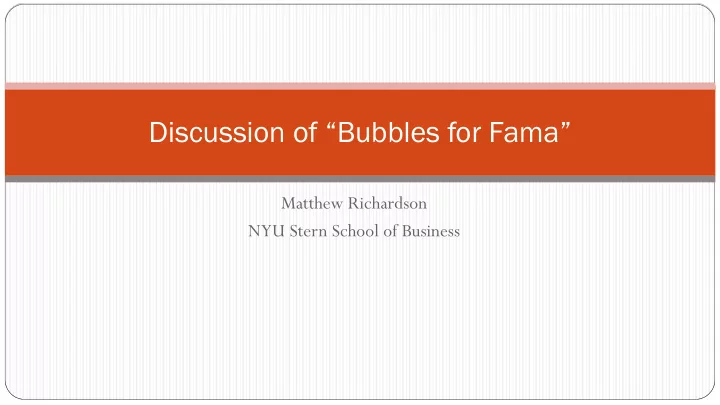

Discussion of “Bubbles for Fama” Matthew Richardson NYU Stern School of Business
This paper: Stock prices of a U.S industry has increased 100% in both raw and excess returns over previous two years. Call this B . Authors look at the time period 1928-2013 (and augment this with international data from 1987-2013). Identify 40 B s. Four findings: B does not forecast future returns B does predict higher probability of a crash (call this C ). Characteristics of industry with a B look different when there is a subsequent C versus non- C A subset of these characteristics of a B do help forecast future returns.
This discussion: Is B really a bubble? Is C really a crash? Alternative facts (not K. Conway style) Alternative model Comment on sample size & characteristics analysis
The paper starts with this quote from Fama: “ For bubbles, I want a systematic way of identifying them. It’s a simple proposition. You have to be able to predict that there is some end to it. All the tests people have done trying to do that don’t work. Statistically, people have not come up with ways of identifying bubbles .” Eugene Fama, June 2016
THANKS FOR NOTHING, YOU NBER BRAINS (NY Post, Dec 23, 2001) Those econo-wonks at the National Bureau of Economics Research are at it again. In November, the venerable group of economists descended from their ivory tower to declare what anyone not in a coma already knew – that the U.S. was in recession. Now, more than a year since the dot-coms bombed, driving down stocks as much as 70 percent and closing the door on the longest U.S. economic expansion, the NBER’s academics put their frontal lobes together to explain why the bubble burst. “It is possible that ‘optimistic’ investors overwhelm ‘pessimistic’ ones, leading to [stock] prices not reflecting fundamental values . . . ,” says Eli Ofek and Matthew Richardson in their NBER Working Paper issued this month.
4 120 3.5 100 3 80 2.5 60 2 40 1.5 1 20 0.5 0 10/1/2010 10/1/2011 10/1/2012 10/1/2013 10/1/2014 0 1/1/1999 1/1/2000 1/1/2001 1/1/2002 25 250 20 200 150 15 100 10 50 5 0 6 6 6 6 7 7 7 7 7 7 8 8 8 8 1 1 1 1 1 1 1 1 1 1 1 1 1 1 0 0 0 0 0 0 0 0 0 0 0 0 0 0 2 2 2 2 2 2 2 2 2 2 2 2 2 2 0 / / / / / / / / / / / / / / 3 3 3 3 3 3 3 3 3 3 3 3 3 3 1 1 1 1 1 1 1 1 1 1 1 1 1 1 3/4/2005 3/4/2006 3/4/2007 3/4/2008 3/4/2009 / / / / / / / / / / / / / / 5 7 9 1 1 3 5 7 9 1 1 3 5 7 1 1
4 120 3.5 100 3 80 2.5 60 2 40 1.5 1 20 0.5 0 10/1/2010 10/1/2011 10/1/2012 10/1/2013 10/1/2014 0 1/1/1999 1/1/2000 1/1/2001 1/1/2002 25 250 20 200 150 15 100 10 50 5 0 6 6 6 6 7 7 7 7 7 7 8 8 8 8 1 1 1 1 1 1 1 1 1 1 1 1 1 1 0 0 0 0 0 0 0 0 0 0 0 0 0 0 2 2 2 2 2 2 2 2 2 2 2 2 2 2 0 / / / / / / / / / / / / / / 3 3 3 3 3 3 3 3 3 3 3 3 3 3 1 1 1 1 1 1 1 1 1 1 1 1 1 1 3/4/2005 3/4/2006 3/4/2007 3/4/2008 3/4/2009 / / / / / / / / / / / / / / 5 7 9 1 1 3 5 7 9 1 1 3 5 7 1 1 AAPL
What’s a Crash? This paper chooses a 40% max drawdown ( DD Max ) over the following 2-year period as a crash. Suppose prices follow a Brownian motion with zero drift and volatility parameter, s . Then the expected max drawdown over T periods is: [ ] = s p E DD T Max 2 With the median industry s equal to 26% (net of mkt 20%), the expected 2-year max drawdown is around 40%!!! (With a drift and SR=.4, E[ DD Max ] is approximately 33%).
Simulated 2-year DD DD Max Max Expected Value & Probability
B does predict higher probability of a crash (call this C ).
B does predict higher probability of a crash (call this C ). But so does –B !!!
B does not forecast future returns; neither does -B
What’s going on? Theoretically, E[ DD Max ] & Prob[ DD Max ] are linear in s , and, more generally, depend on other moments of the distribution like skewness/kurtosis/other tails. Perhaps, big run-ups ( B ) or run-downs ( -B ) are just capturing the changing conditional distribution of that industry, i.e., current large s and other tails. This is why you get high C probability for both B and –B (like earlier AAPL), not sure it is about Fama’s “ Bubbles ”.
One final thought: Sample size Not a ton of data 40+ nonoverlapping 2-year periods; B : maybe 1 per sample 48 industries but correlated (median correlation 55%, net of mkt 10%) 48 but theoretically have maybe 16-24; looks like 20 in the data So 20 B , with half of them resulting in a subsequent C , i.e., 10 C versus 10 non- C . Look at multiple characteristics (turnover, vol, age, issuance, fundamentals, …) to try and differentiate between 2 sets of just 10 events ( ???) No magical SE procedure can change this. (Maybe look at SE properties in small samples.)
Recommend
More recommend